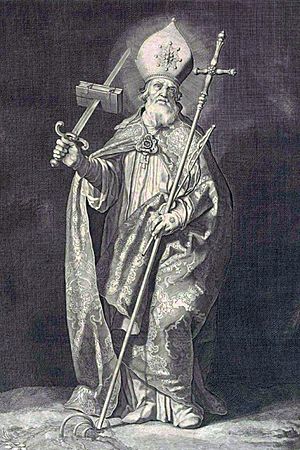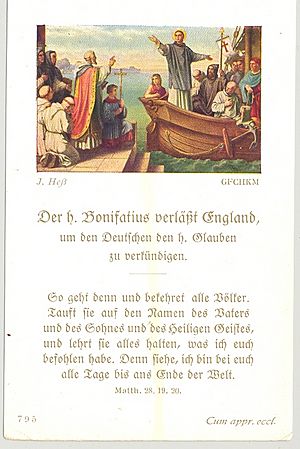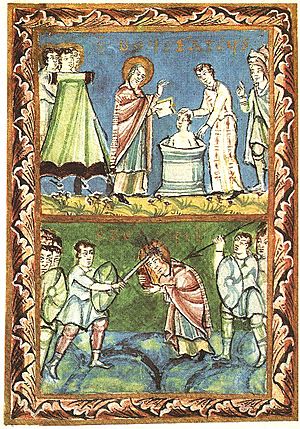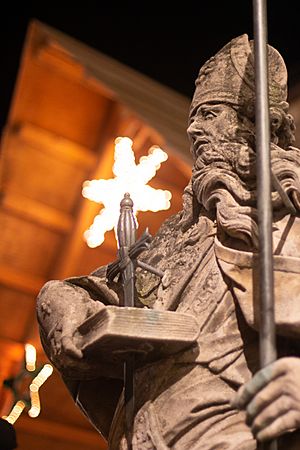Saint Boniface facts for kids
Quick facts for kids SaintBoniface OSB |
|
|---|---|

Saint Boniface by Cornelis Bloemaert, c. 1630
|
|
| Bishop Martyr Apostle to the Germans |
|
| Born | c. 675 Crediton, Dumnonia |
| Died | 5 June 754 (aged around 79) near Dokkum, Frisia |
| Venerated in | Catholic Church Eastern Orthodox Church Anglican Communion Lutheranism |
| Major shrine | Fulda Cathedral St Boniface Catholic Church, Crediton, UK |
| Feast | 5 June |
| Attributes | In bishop's robes, book pierced by a sword (also axe; oak; scourge) |
| Patronage | Fulda; Germania; England (Orthodox Church; jointly with Ss. Augustine of Canterbury, and Cuthbert of Lindisfarne. The Orthodox Church also recognises him as patron Saint of Germany); Devon |
Saint Boniface (born Winfrid or Winfred, around 675 – June 5, 754) was an English monk. He was a very important leader in spreading Christianity in the Frankish Empire during the 700s. He helped set up many churches in Germany.
Pope Gregory III made him the archbishop of Mainz. Boniface was killed in Frisia in 754, along with 52 other people. His body was brought back to Fulda, Germany. His tomb there is now a place where many people visit.
Boniface's life and work became well known. We know a lot about him from his letters and old stories. He is honored as a saint in the Christian church. He is also known as the "Apostle to the Germans" because of his work there.
Historians say Boniface played three key roles. He helped spread Christianity in Germany. He also reformed the Frankish church. Plus, he helped create a strong link between the Pope and the Carolingian family. His efforts helped shape the church in Europe. Many of the church areas he set up still exist today.
After he died, people quickly honored him as a saint. He is still highly respected by Catholics in Germany. Boniface is seen as a great missionary. He is also considered a person who helped unite Europe.
In 2019, Devon County Council officially recognized Saint Boniface. He is now the Patron Saint of Devon, England.
Contents
Early Life and Training
Boniface was born in England around 675. His English name was Winfrid or Winfred. Early stories say he went to a monastery in Exeter when he was young. This monastery might have been on the site of the old Church of St Mary Major. Later stories say he was born in Crediton.
Winfrid came from a respected and wealthy family. But he chose to become a monk when he was young, even though his father didn't want him to. He studied at the Benedictine monastery of Nursling, near Winchester. This monastery was a busy learning center.
Winfrid taught at the abbey school. At age 30, he became a priest. During this time, he wrote a Latin grammar book. He also wrote about poetry and some riddles. The library at Nursling was very good. It had many important books that helped Boniface learn.
Around 716, Winfrid was asked to become the abbot of Nursling. But he said no. Instead, he decided to go on a missionary trip to Frisia.
First Missions to Europe
Boniface first went to Europe in 716. He traveled to Utrecht to meet Willibrord. Willibrord was known as the "Apostle to the Frisians." Boniface worked with Willibrord for a year. They preached in the countryside. But a war between Charles Martel and King Radbod of the Frisians stopped their work. Willibrord went to his abbey, and Boniface returned to Nursling.
The next year, Boniface went straight to Rome. Pope Gregory II gave him a new name, "Boniface." He was named after an old saint. The Pope then made him a missionary bishop for Germany. This meant he was a bishop without a specific church area. He would never return to England, but he kept writing to his family and friends there.
One famous story says Boniface cut down the Donar Oak. This was a sacred tree near the town of Fritzlar in Germany. People believed it was dedicated to a pagan god. As Boniface started to chop, a strong wind blew the tree over. When the gods didn't strike him down, the people were amazed. Many of them decided to become Christians. Boniface built a small church from the wood of the tree. This church was the start of a monastery in Fritzlar.
Boniface and the Frankish Rulers
The support of the Frankish leaders was very important for Boniface's work. From 723, Boniface was protected by Charles Martel. The Frankish leaders wanted to defeat the pagan Saxons. They also wanted to add Saxon lands to their growing empire. Boniface's work of removing pagan sites helped the Franks in their fight against the Saxons.
In 732, Boniface went to Rome again. Pope Gregory III made him an archbishop. He was given power over the church in what is now Germany. Boniface continued his mission. He also worked to improve the relationship between the Pope and the Frankish church. Rome wanted more control over the Frankish church. Boniface felt it was too focused on worldly things.
During his third visit to Rome in 737–738, he became the Pope's special representative for Germany. After this trip, Charles Martel created four church areas in Bavaria. He made Boniface the main archbishop over all of Germany east of the Rhine River. In 745, he was given Mainz as his main church city.
In 742, one of Boniface's students, Sturm, founded the abbey of Fulda. Boniface was very involved in setting up this abbey. Boniface told his friend Daniel of Winchester that without Charles Martel's protection, he couldn't do his church work.
Boniface also set up new church areas in other parts of Germany. He appointed his own followers as bishops. This helped him keep some independence from the Frankish rulers. The rulers were happy as long as Christianity was spreading among the Germanic tribes.
Last Mission and Death
Boniface always hoped to convert the Frisians. In 754, he went to Frisia with his helpers. He baptized many people. He then called a large meeting for them near Dokkum. But instead of new converts, a group of armed robbers arrived. They killed the old archbishop and his companions.
The stories say Boniface told his friends to put down their weapons. He said, "Stop fighting. Lay down your arms, for we are told in Scripture not to render evil for evil but to overcome evil by good."
After killing Boniface, the robbers searched their belongings. They hoped to find gold and silver. But they found only books and sacred texts. They tried to destroy these books. One of these books, the Ragyndrudis Codex, is now a relic in Fulda. It shows cuts that might have been made by a sword or axe.
Boniface's body was moved to Utrecht, then to Mainz. Finally, his remains were buried in the abbey church of Fulda. They rest in a shrine under the main altar of Fulda Cathedral.
Honoring Saint Boniface
Fulda
People started honoring Boniface in Fulda right after he died. His tomb became the center of the abbey. Monks would pray at his grave. Every Monday, they remembered him in prayer. When the abbey church was rebuilt, Boniface's remains were moved to a new grave. He was seen as the protector of the abbey. He was honored on June 5, the day he died.
Dokkum
The stories also tell how a well appeared at the site of his death in Dokkum. This well became a "fountain of sweet water." People used it to bless themselves. A church was built there later. The well was important because Boniface's body was far away. It helped people feel connected to the saint. It also showed Dokkum's link to the rest of Christian Europe.
Memorials and Celebrations
Saint Boniface's special day is celebrated on June 5. This is done in the Roman Catholic Church, the Lutheran Church, the Anglican Communion, and the Eastern Orthodox Church.
There is a famous statue of Saint Boniface at the Mainz Cathedral in Germany. Another modern statue stands in Fritzlar.
In the United Kingdom, the national shrine to Saint Boniface is at the Catholic church in Crediton, Devon. There is a sculpture there showing him cutting down Thor's Oak. Many churches in the UK are named after him. St Boniface Down, the highest point on the Isle of Wight, is also named after him.
In Canada, Father Norbert Provencher founded a mission in 1818. He built a church and named it after St. Boniface. This area grew into the city of Saint Boniface, which is now part of Winnipeg. It is the main French-speaking area in Winnipeg. St. Boniface Hospital was also built there.
Legends
Some stories say Saint Boniface invented the Christmas tree. However, the oldest writings about him do not mention this. This legend appears in some modern books and websites.
Images for kids
-
A statue of Saint Boniface in Fulda, Germany.
See also
 In Spanish: Bonifacio de Maguncia para niños
In Spanish: Bonifacio de Maguncia para niños










